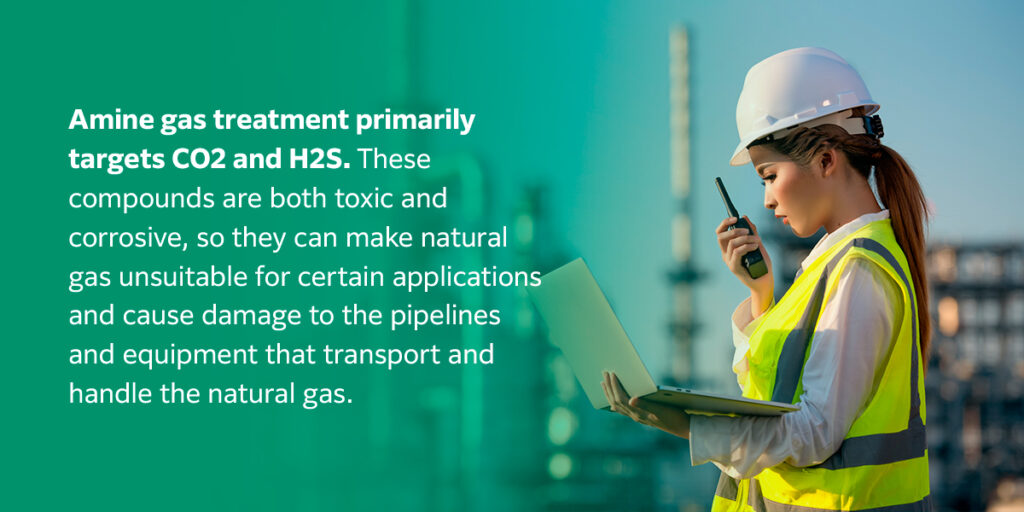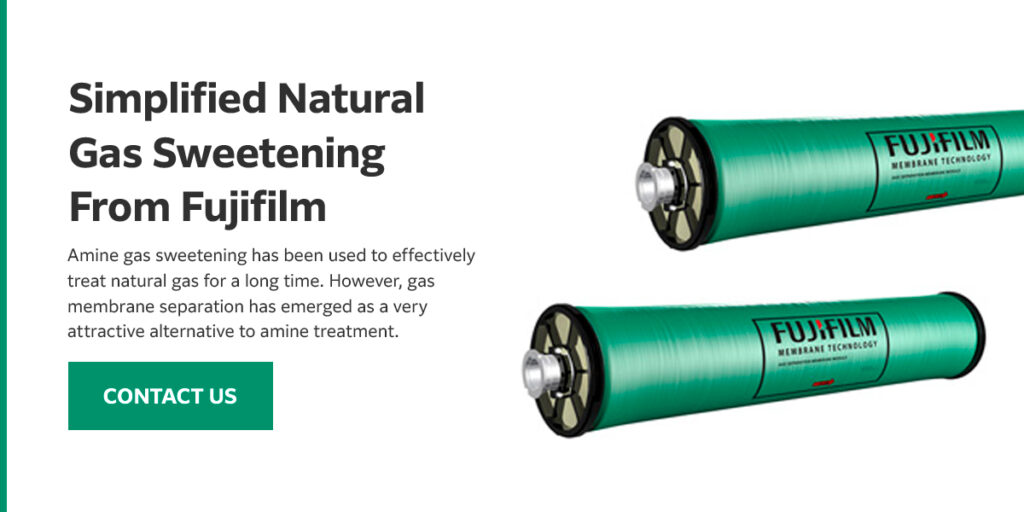
Jump to:
- How Does Amine Gas Treatment Work?
- Pros and Cons of Amine Gas Treatment
- Amine Treatment Alternatives
When natural gas is pulled from its source, it typically has undesirable components mixed in that would make the gas unusable for most applications. Amine gas treatment is a method of removing some of those components, namely carbon dioxide (CO2) and hydrogen sulfide (H2S). Natural gas containing measurable amounts of CO2 and H2S is often referred to as being “sour.” Amine systems use chemical absorption to clean up or “sweeten” the “sour” natural gas.
Amine gas treatment has been used to sweeten natural gas for many years and can be a very effective solution, especially when acid gas concentrations are very low. However, there are other natural gas sweetening options available, and the right one depends on your application.
How Does Amine Gas Treatment Work?

Amine gas treatment primarily targets CO2 and H2S. These compounds are both toxic and corrosive, so they can make natural gas unsuitable for certain applications and cause damage to the pipelines and equipment that transport and handle the natural gas.
The level of acid gas (CO2/H2S) removal from natural gas depends on the specific application. For example, for natural gas pipelines, the specifications for maximum levels of CO2 and H2S are 2.0% and 4 ppm (mol), respectively. When feeding natural gas to a liquified natural gas (LNG) process, the maximum level of CO2 permitted is 50 ppm (mol).
The amine gas treatment process usually comprises the following:
- Acid gas absorption: The “sour” incoming gas — which is contaminated with CO2 and H2S — flows through a contactor tower, where it makes contact with an amine solution flowing counter-current to the natural gas. The amine solution has a chemical affinity for CO2 and H2S and absorbs these acid gas components. The “sweet” natural gas — i.e., natural gas with CO2 and H2S removed, flows out of the top of the absorber tower.
- Amine solution regeneration: The amine solution is now considered “rich” because it carries the absorbed acid gases. The rich amine solution leaves the tower and is heated via a heat exchanger before entering the regeneration still column. Heat from the regeneration still column reboiler is used to heat the rich amine solution, releasing the CO2 and H2S from the amine solution.
- Material separation and recovery: The water-saturated acid gases that were separated from the rich amine are then cooled and condensed. A reflux accumulator separates the condensed water and amine solution and sends them back to the regeneration still. The regenerated or lean amine gets cooled down in a heat exchanger with the rich amine solution before being circulated around to the contactor tower, where the process starts over.
The natural gas exiting the top of the absorber tower is void of CO2 and H2S. Because the amine solution is water-based, the sweet natural gas exiting the absorber tower is water-saturated and will almost always require a separate dehydration step before entering the pipeline.
Many types of amines are available, each of which offers certain characteristics. Selecting an amine is a careful process, and you need to consider factors like the quality of the incoming gas, specific acid gas components concentrations, target concentrations, process conditions such as pressure and temperature and, finally, environmental and ambient conditions.
Some commonly used amines include:
- Monoethanolamine (MEA): MEA is often used in low-pressure applications with stringent specifications.
- Methyl diethanolamine (MDEA): MDEA does a better job of removing H2S than CO2, which allows for CO2 “slip” while removing H2S.
- Diethanolamine (DEA): DEA is best for high-pressure treatments and doesn’t need to be reclaimed like some other amines.
Suppliers can also use a custom formulation for specialty applications or more targeted results.
Pros and Cons of Amine Gas Treatment
Amine gas treatment has a long history and offers benefits like:
- High efficacy: Amine gas treatment can remove acid gas concentrations to very low concentrations, yielding treated or sweet gas with almost 0 ppm of H2S and CO2.
- Treatment for both CO2 and H2S: Amines can target both of these compounds in a single system.
Some disadvantages of amine gas treatment include:
- Specificity: Since the amine must be selected according to the characteristics of a given system or area, these materials can vary in cost, selectivity, concentration and physical characteristics.
- High ongoing costs: Amine gas systems can become extremely expensive, especially when treating CO2 concentrations above 10%. Also, amine gas systems typically have higher operating costs than many other gas-sweetening solutions.
- Higher environmental burden: Amine treatment creates waste through amine salts and uses a lot of chemicals. They need to be responsibly disposed of and regularly resupplied, which leads to a higher environmental burden.
Amine Treatment Alternatives
Although amine gas treatment has a long history of removing acid gas from natural gas, amine gas sweetening isn’t the only way to remove CO2 and H2S from a natural gas supply. One of the primary alternatives to amine gas sweetening is gas separation membrane technology. While amine gas treatment relies on a chemical process, gas separation membrane technology uses more of a chemical-mechanical process.
Gas separation membrane technology relies on the principle that gases dissolve in and diffuse through a thin polymer barrier via a partial pressure difference across that polymer barrier. Certain gases, primarily CO2, H2S and H2O, will pass through or permeate across the polymer membrane faster than hydrocarbon gases due to a difference in the solubility of these gases in the polymer and the rate at which these gases diffuse through the polymer membrane structure.
The actual permeance, or permeability/flux, of a given component is a function of the feed gas pressure, feed gas temperature and component feed gas concentration. The selectivity of the membrane is actually the ratio of individual component permeance or permeabilities and essentially represents the ability of the membrane to separate the faster and slower permeable components. The most effective membranes offer high permeability and high selectivity and can even be modified to meet your application’s specific demands.
When compared to amine gas sweetening, membrane gas separation offers:
- Easier installation and operation: Gas membrane systems are usually skid-mounted and ready to operate. These systems are much smaller and simpler than amine treatment systems, which are complex and have many components and moving parts to maintain. Gas membrane units are easy and quick to install. They are also inexpensive to operate and maintain.
- Lower capital and operating expenditures: Gas membrane systems generally provide lower capital expenditures (Capex) and operating expenditures (Opex) than amine treatment systems. This is especially true for Fujifilm’s next-generation Apura gas membranes which offer much more stable flux and substantially longer life.
- No hazardous chemicals: Gas membrane systems have no circulating liquids like amine treatment systems, yielding no problems associated with spillage or the handling or disposal of hazardous chemicals.
- No need for a dehydration unit: Gas membrane systems generally dehydrate the feed natural gas while CO2 and H2S are removed, as H2O is also a very fast-permeating gas, eliminating the need for a separate dehydration unit.
- Reduced emissions: Amine treatment systems rely on several processes involving heaters, burners, pumps and other equipment that can produce methane, CO2 or volatile organic compounds (VOCs). Gas membrane systems have significantly reduced emissions compared to amine treatment systems.
- Modularity: Due to their modular nature, gas membrane systems can easily and inexpensively be modified to handle changes in processing requirements, including increases and decreases in flow rate, pressure, concentration, etc.
Many natural gas suppliers and operators, especially those with very stringent acid gas specifications, choose to combine the benefits of amine treatment systems with gas membrane systems by installing a gas membrane upstream of the amine treatment system. The hybrid amine-membrane system utilizes the cost savings associated with the bulk removal of CO2 and H2S via the gas membrane system while still delivering the efficient, deep-cut treatment of the much smaller amine treatment system.

Simplified Natural Gas Sweetening From Fujifilm
Amine gas sweetening has been used to effectively treat natural gas for a long time. However, gas membrane separation has emerged as a very attractive alternative to amine treatment. As a leader in industrial materials, Fujifilm has developed next-generation, high-performing polymeric gas membrane elements to help natural gas suppliers and operators improve their gas treatment processes, i.e. reaping the benefits from faster startup to reduced Capex and Opex to reduced physical and environmental footprints.
Our solutions include the Apura™️ 1.5XF and Apura™️ 2.0C to remove CO2, H2S and H2O. These durable, long-lasting gas membrane modules offer exceptional performance and stability even in tough conditions, at pressures up to 83 bar and temperatures up to 60 degrees C.
Whether you’re looking to supplement an amine treatment system or replace or build a new gas treatment system, Fujifilm can help you get there. To learn more about our gas membrane separation products, reach out to us today.













